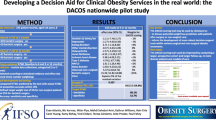Bariatric surgery is the only currently available, effective, long-term method for controlling morbid obesity. ‘Long-term’ non-surgical, medical, voluntary weight loss data is rare; where it exists, it averages only 5-10% of patients' total body weight - of minimal long-term value for the morbidly obese - and has a consistently high failure rate, with many patients ultimately progressing to disability, End-Stage Obesity Syndrome or premature death. The author predicts that the time will come when most members of the lay and medical communities accept that bariatric surgery is the conservative approach to treatment for the morbidly obese. The mechanism will be by bariatric surgeons gathering and reporting data on their morbidly obese patients from the options presented. Data collection may take the form of controlled, randomized, descriptive, case or group studies of surgical and non-surgical therapies upon patients' psycho-socio- economic-physical-behavioral-medical co-morbidities. Stressed is the concept that all bariatric surgeons have the capability and the implied duty to analyse their patients' data and disseminate the results, in part to achieve the predicted improvement in medical and lay acceptance of bariatric surgery as a conservative concept.
Similar content being viewed by others
Author information
Authors and Affiliations
Rights and permissions
About this article
Cite this article
Cowan, G.S.M. A Predicted Future for Bariatric Surgery: Using the Surgical Model. OBES SURG 6, 12–16 (1996). https://doi.org/10.1381/096089296765557213
Published:
Issue Date:
DOI: https://doi.org/10.1381/096089296765557213




